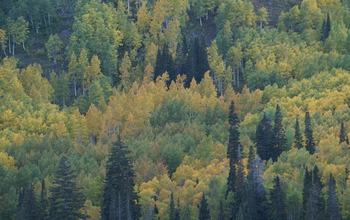 Credit and Larger Version |
September 26, 2013
Have you looked closely at a local pond, meadow or forest and observed changes in it over time? That's exactly what scientists are trying to do on a larger, regional to continental scale--a macrosystems biology scale.
Macrosystems biology might be called biological sciences writ large.
To better detect, understand and predict the effects of climate and land-use change on organisms and ecosystems at regional to continental scales, the National Science Foundation (NSF) Directorate for Biological Sciences recently awarded $15.3 million in 10 new macrosystems biology grants.
Since the Macrosystems Biology program was launched in 2011, NSF has made 50 such awards.
How will the biosphere respond to natural and human-induced changes across a range of time and space scales? What is the pace and pattern of these responses? What are the effects on ecosystem services--such as the availability of freshwater--across regions and continents?
"Scientists conducting macrosystems biology research are working to find answers to these complex questions," says John Wingfield, NSF assistant director for Biological Sciences.
"Current knowledge of the biosphere is largely based on research in small plots of land and on satellite-scale remote sensing," says Wingfield. "But the insights needed to answer critically important questions about the biosphere's future can't always be extrapolated from such studies. They require new approaches."
A significant part of these new approaches involves the integration of biology with other fields, Wingfield says, including the geosciences, engineering, mathematical and physical sciences, and social, economic and behavioral sciences.
Among the questions NSF's macrosystems biology awardees will ask are:
How are regional-scale processes in plant and animal invasions, and in disease transmission, shaped by continent-wide environmental and land-use patterns? How can continent-wide data lead to better forecasts of disease outbreaks? How do invasive species and infectious diseases arrive at new locations, sometimes across great distances?
Projects include studies of the influence of time and space scales on host-parasite interactions; modeling birds' responses to climate change; quantifying climate-forced extinction risks for lizards, amphibians, fish and plants; building local effects of forest management into Earth system models at continental scales; and investigating methane emissions from far Northern peatlands.
The projects criss-cross regions and continents, and bring together scientists from biological sciences, geosciences and other fields in an effort to find out what makes Earth's biosphere tick.
2013 NSF Macrosystems Biology Awards
Randall Boone, Colorado State University,
Additional Collaborator: Sunil Kumar, Colorado State University
Elizabeth Borer, University of Minnesota-Twin Cities,
Additional Collaborators: Linda Kinkel, Georgiana May and Eric Seabloom, University of Minnesota-Twin Cities; and Kevin Gross, North Carolina State University
Songlin Fei, Purdue University,
Additional Collaborators: Bryan Pijanowski, Purdue University; and Qinfeng Guo and Christopher Oswalt, USDA Forest Service Southern Research Station
Jason McLachlan, University of Notre Dame,
Additional Collaborators: Michael Dietze, Trustees of Boston University; Paul Duffy, Neptune and Company, Inc.; Andrew Finley, Michigan State University; Stephen Jackson, University of Wyoming; Philip Higuera, University of Idaho; Mevin Hooten, Colorado State University; Jennifer Marlon, Yale University; David Moore, University of Arizona; Neil Pederson, Columbia University; and John Williams and Jun Zhu, University of Wisconsin-Madison
Jason Rohr, University of South Florida,
Additional Collaborator: Barry Sinervo, University of California-Santa Cruz
Benjamin Ruddell, Arizona State University,
Additional Collaborator: Daniel Childers, Arizona State University
Barry Sinervo, University of California-Santa Cruz,
Additional Collaborators: Aaron Bauer, Villanova University; Donald Miles, Ohio University; Jarmila Pittermann, University of California-Santa Cruz; and Jack Sites, Brigham Young University
Christina Staudhammer, University of Alabama Tuscaloosa,
Additional Collaborators: Michael Binford, University of Florida; Lindsay Boring, J W Jones Ecological Center; Ankur Desai, University of Wisconsin-Madison; Michael Dietze, Trustees of Boston University; Paul Duffy, Neptune and Company, Inc.; Jerry Franklin, University of Washington; Robert Mitchell, Ichauway, Inc.; Gregory Starr, University of Alabama Tuscaloosa; and Paul Stoy, Montana State University
Christopher Still, Oregon State University,
Additional Collaborators: Michael Goulden, University of California-Irvine; Brent Helliker, University of Pennsylvania; Rebecca Powell, Wake Forest University; Andrew Richardson, Harvard University; and Dar Roberts, University of California-Santa Barbara
Ruth Varner, University of New Hampshire,
Additional Collaborators: Bobby Braswell, Applied GeoSolutions, LLC; Mark Hines, University of Massachusetts Lowell; Changsheng Li, University of New Hampshire; Michael Palace, University of New Hampshire; and Scott Saleska, University of Arizona
-NSF-
Media Contacts Cheryl Dybas, NSF (703) 292-7734 cdybas@nsf.gov
The National Science Foundation (NSF) is an independent federal agency that supports fundamental research and education across all fields of science and engineering. In fiscal year (FY) 2012, its budget was $7.0 billion. NSF funds reach all 50 states through grants to nearly 2,000 colleges, universities and other institutions. Each year, NSF receives about 50,000 competitive requests for funding, and makes about 11,500 new funding awards. NSF also awards about $593 million in professional and service contracts yearly.
Useful NSF Web Sites:
NSF Home Page:
NSF Home Page:
http://www.nsf.gov
NSF News:
NSF News:
http://www.nsf.gov/news/
For the News Media:
For the News Media:
http://www.nsf.gov/news/newsroom.jsp
Science and Engineering Statistics:
Science and Engineering Statistics:
http://www.nsf.gov/statistics/
Awards Searches:
Awards Searches:

MSB awardees are quantifying extinction risks for amphibians, lizards, fish and plants.
Credit and Larger Version

Leaves, canopies, regions, and how they're affected by temperatures: the subject of an MSB award.
Credit and Larger Version

MSB scientists are investigating peatland methane from local to regional to continental scales.
Credit and Larger Version

Modeling how birds respond to climate change is the subject of an MSB award.
Credit and Larger Version

The influence of time and space scales on host-parasite interactions is an MSB grant topic.
Credit and Larger Version
The National Science Foundation (NSF)
Guillermo Gonzalo Sánchez Achutegui

No hay comentarios:
Publicar un comentario